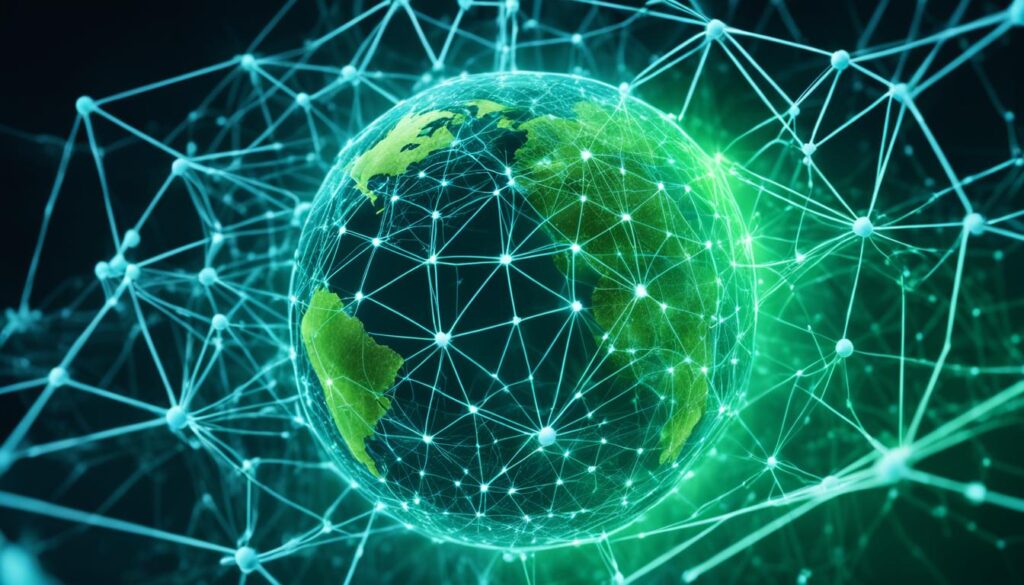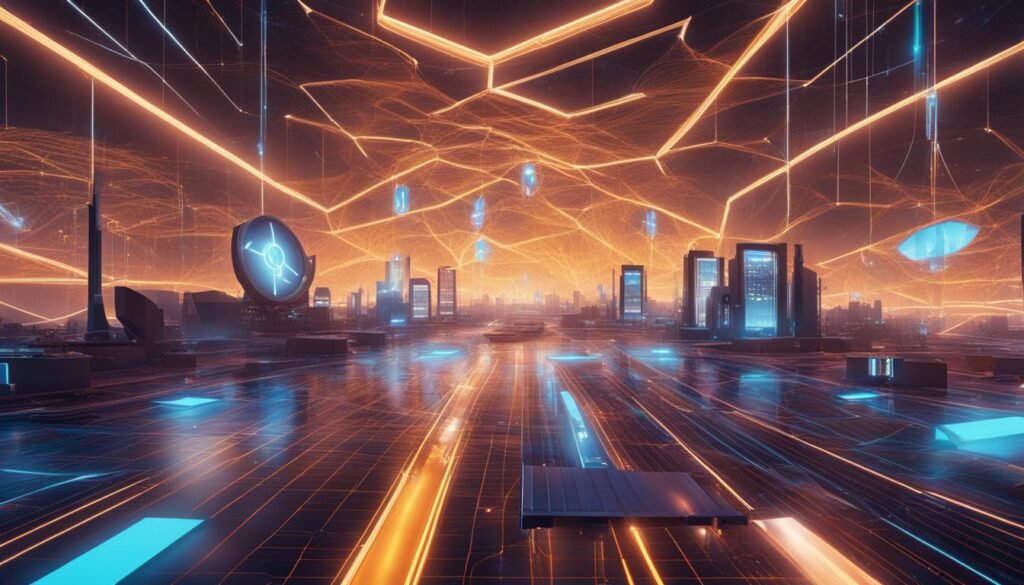Welcome to the future of decentralized energy markets in Web 3.0! In this article, we will explore how Web 3.0 is set to revolutionize the energy industry and shape the future of decentralized energy systems. With advanced technologies like blockchain and renewable energy trading, Web 3.0 holds the key to creating a more efficient, transparent, and sustainable energy market.
Web 3.0 represents the next phase in the evolution of the internet, where decentralized networks and peer-to-peer interactions take center stage. By leveraging blockchain technology, energy platforms can be built on decentralized networks, eliminating the need for intermediaries and enabling direct trading between energy producers and consumers.
With blockchain in energy markets, transactions can be verified, recorded, and automated through smart contracts. These self-executing contracts ensure transparency, security, and efficiency in energy trading. Decentralized energy platforms powered by Web 3.0 have the potential to transform the way energy is bought, sold, and consumed.
Key Takeaways:
- Web 3.0 is revolutionizing decentralized energy markets through blockchain technology.
- Decentralized energy platforms enable direct trading between producers and consumers.
- Smart contracts automate energy transactions, ensuring transparency and efficiency.
- Web 3.0 promotes innovation in the energy market through decentralized applications (Dapps).
- Energy exchange platforms on blockchain can lead to lower costs and more competitive pricing.
As we dive deeper into the world of Web 3.0 energy systems, we will examine the benefits it brings, the challenges it faces, and the potential it holds for a sustainable and decentralized energy future.
Understanding Web 3.0 and its Impact on Energy Markets
The emergence of Web 3.0, a decentralized internet environment, has the potential to transform energy markets as we know them. By harnessing cutting-edge technologies, such as blockchain and smart contracts, Web 3.0 enables the development of decentralized energy platforms that revolutionize the way energy is traded and consumed.
Blockchain, a distributed ledger technology, lies at the heart of Web 3.0’s impact on energy markets. It offers a secure and transparent platform for peer-to-peer energy transactions, eliminating the need for intermediaries and reducing costs. Decentralized energy platforms built on blockchain networks create direct connections between energy producers and consumers, fostering greater efficiency, trust, and sustainability.
Smart contracts are another key element of Web 3.0 technology that is reshaping energy markets. These self-executing contracts automate energy transactions, ensuring transparency and efficiency. By removing the need for manual processes and intermediaries, smart contracts streamline the trading process and enable real-time settlements.
Furthermore, the use of blockchain technology in energy markets enhances security and data privacy. Through its decentralized nature, blockchain reduces the risk of fraud and unauthorized tampering of energy transaction records, providing a higher level of trust and integrity.

The shift towards decentralized energy platforms empowered by Web 3.0 technologies holds immense potential. It empowers individuals and businesses to actively participate in the energy market, facilitating the efficient exchange of renewable energy and driving the transition to a more sustainable future. The following table illustrates the key features and benefits of Web 3.0 and its impact on energy markets:
| Key Features | Benefits |
|---|---|
| Decentralized energy platforms | Enables peer-to-peer energy trading, eliminating intermediaries and reducing costs |
| Smart contracts | Automates energy transactions, ensuring transparency and efficiency |
| Enhanced security and data privacy | Reduces the risk of fraud and unauthorized tampering of energy transaction records |
As Web 3.0 continues to evolve, the energy market will witness a paradigm shift towards decentralized systems driven by blockchain and smart contracts. With increased accessibility, efficiency, and transparency, Web 3.0 technologies have the potential to shape a more sustainable and inclusive energy future.
The Benefits of Web 3.0 in Decentralized Energy Markets
Web 3.0 brings several benefits to decentralized energy markets. One of the key advantages is the emergence of energy exchange platforms built on blockchain technology. These platforms enable direct trading between energy producers and consumers, eliminating the need for intermediaries and creating a more efficient and transparent market. By facilitating peer-to-peer transactions, energy exchange platforms can significantly lower transaction costs and enable more competitive pricing for all participants.
Additionally, Web 3.0 promotes innovation in the energy market through the development of decentralized applications (Dapps). These Dapps have the potential to optimize energy usage, enable peer-to-peer energy sharing, and facilitate the integration of renewable energy sources into the grid. For example, Dapps can enable consumers to monitor and manage their energy consumption in real-time, allowing for more efficient use of resources. Furthermore, peer-to-peer energy sharing can empower individuals to trade excess energy with their neighbors, creating a more sustainable and resilient energy ecosystem.
The Advantages of Energy Exchange Platforms:
- Direct trading between energy producers and consumers
- Efficient and transparent market
- Lower transaction costs
- Competitive pricing
The Potential of Decentralized Applications (Dapps):
- Optimization of energy usage
- Peer-to-peer energy sharing
- Integration of renewable energy sources
These advancements in Web 3.0 have the potential to accelerate the transition towards a more sustainable energy future. By leveraging energy exchange platforms and decentralized applications, individuals and communities can play an active role in shaping the energy market and driving innovation. The integration of renewable energy sources and the optimization of energy usage can contribute to a cleaner and more resilient energy ecosystem.
Web 3.0 and its benefits in decentralized energy markets lay the foundation for a more democratic and accessible energy system, where individuals have greater control over their energy consumption and production. With continued development and adoption of these technologies, the energy market is poised for significant transformation, leading to a more sustainable and decentralized energy future.

Overcoming Challenges in Web 3.0 Energy Systems
While implementing Web 3.0 in energy markets offers significant benefits, it also comes with its own set of challenges. The decentralized nature of Web 3.0 energy systems introduces technical complexities that must be addressed for successful implementation. One such challenge is ensuring scalability and interoperability between different blockchain networks. As decentralized energy markets evolve, it is important to establish regulatory and legal frameworks that can govern these systems and provide necessary consumer protection.
In addition, privacy and security concerns need to be carefully addressed to build trust in Web 3.0 energy systems. With data being shared and stored on a distributed ledger, it is crucial to design robust security measures to protect sensitive information. Collaborative efforts among developers, industry experts, and regulators are essential in overcoming these challenges and unlocking the full potential of Web 3.0 in decentralized energy markets.
“The successful implementation of Web 3.0 in energy markets requires bridging technical complexities, establishing regulatory frameworks, and prioritizing data privacy and security.”
Scalability and Interoperability
One of the main technical challenges in Web 3.0 energy systems is ensuring scalability and interoperability between different blockchain networks. As the number of participants and energy transactions increase, the underlying technology must be able to handle the growing demand. This requires developing scalable solutions that can process a large volume of transactions without compromising efficiency.
Furthermore, interoperability between various blockchain networks is crucial for seamless integration and efficient communication between different participants in the decentralized energy market. Interoperability standards and protocols need to be developed to ensure compatibility and smooth operation across different platforms.
Regulatory and Legal Frameworks
As decentralized energy markets gain traction, it becomes imperative to establish regulatory and legal frameworks that can govern these systems effectively. Clear guidelines and regulations are needed to ensure fair competition, protect consumer rights, and maintain market integrity. By setting the right rules and regulations, regulators can foster a favorable environment for innovation, investment, and healthy market competition.
Collaboration between industry stakeholders and regulators is crucial to address regulatory challenges and develop frameworks that strike a balance between fostering innovation and ensuring consumer protection.
Privacy and Security
Privacy and security are paramount in Web 3.0 energy systems. As data is shared and stored on a decentralized network, robust security measures must be implemented to protect against unauthorized access, data breaches, and cyber threats. In addition, individuals’ privacy rights need to be safeguarded, ensuring that sensitive energy consumption data is protected and only used with explicit consent.
Developing and implementing privacy-enhancing technologies, encryption methodologies, and secure data storage solutions are critical to building trust in Web 3.0 energy systems.
Conclusion
Web 3.0 has the potential to revolutionize decentralized energy markets and drive energy market innovation. By leveraging blockchain and smart contract technologies, Web 3.0 enables peer-to-peer renewable trading, giving individuals the power to take control of their energy consumption.
With the ability to build energy exchange platforms on decentralized networks, Web 3.0 facilitates direct trading between energy producers and consumers, leading to more efficient and transparent markets. This not only lowers transaction costs but also encourages competition and more competitive pricing.
Moreover, Web 3.0 promotes innovation in the energy market by facilitating the development of decentralized applications (Dapps). These applications optimize energy usage, enable peer-to-peer energy sharing, and integrate renewable energy sources into the grid, accelerating the shift towards a sustainable energy future.
While there are challenges to overcome, such as technical complexities and regulatory frameworks, collaboration among stakeholders is crucial. By addressing these challenges and continuing to develop Web 3.0, we have the potential to reshape the energy market and pave the way for a decentralized and sustainable future.
FAQ
What is Web 3.0 and how does it relate to decentralized energy markets?
Web 3.0 is the next phase of the internet that utilizes advanced technologies like blockchain. It has the potential to revolutionize decentralized energy markets by enabling peer-to-peer renewable trading and eliminating the need for intermediaries.
How does Web 3.0 impact energy markets?
Web 3.0 allows for the development of decentralized energy platforms built on blockchain and smart contracts. This enables direct trading between energy producers and consumers, creating a more efficient and transparent market. Automation through smart contracts ensures transparency and efficiency in energy transactions.
What are the benefits of Web 3.0 in decentralized energy markets?
Energy exchange platforms built on blockchain facilitate direct trading between producers and consumers, leading to lower transaction costs and more competitive pricing. Web 3.0 also promotes energy market innovation through the development of decentralized applications (Dapps) that optimize energy usage and enable peer-to-peer energy sharing.
What challenges need to be overcome in Web 3.0 energy systems?
Technical complexities, such as scalability and interoperability, need to be addressed in decentralized energy systems. Regulatory and legal frameworks must be established to govern these systems and provide consumer protection. Privacy and security concerns also need to be addressed to build trust in Web 3.0 energy platforms.
What is the future of decentralized energy markets in Web 3.0?
Web 3.0 holds great promise for the future of decentralized energy markets. Through blockchain and smart contract technologies, it can enable peer-to-peer renewable trading, enhance energy market innovation, and empower individuals to take control of their energy consumption.








